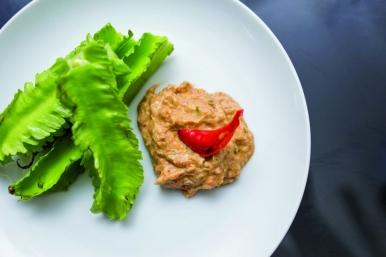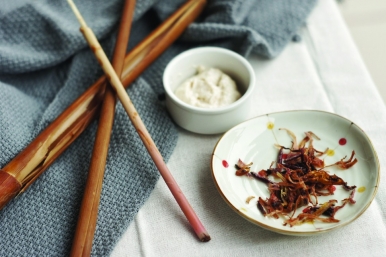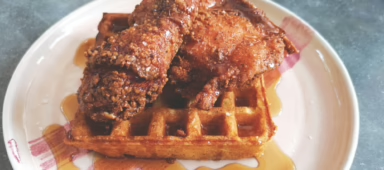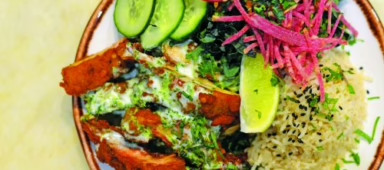Local fish sauce, black nuts and blue flowers merit the culinary world’s attention


When English food doyenne Nigella Lawson proclaimed in 2017 that pandan was poised to become Britain’s next culinary craze, supplanting avocados and green tea powder, many Malaysians who heard the news nodded knowingly.
Pandan leaves, or screwpine, have been ubiquitous in Malaysian kitchens for generations. Nicknamed the vanilla of Southeast Asia, its comfortingly distinctive aroma has infused everything from Malaysian cakes to jellies and jams. It’s essential for constructing the country’s iconic offering of nasi lemak (rice cooked with coconut milk). It’s no flash-in-the-pan novelty.
However, pandan is far from alone in deserving the international spotlight. There are many other culinary components long cherished by Malaysians that could be embraced by food lovers across borders. Here are merely a few of them.

Budu
Budu is a new experience even for most Malaysians. This fish sauce is made mainly by mixing anchovies with salt, left to ferment for as long as six months. It has customarily been consumed by coastal villagers of northeastern Kelantan and Terengganu states, who enjoy it as a pungent, protein-packed condiment to complement rice and vegetables.
But budu has the potential to make the leap into modern cookbooks, as reflected by respected local restaurants. When gastronomic temple Dewakan launched near Kuala Lumpur in 2015, its very first amuse-bouche was crispy edible ‘twigs’ paired with budu-spiked mayonnaise. Popular burger specialist myBurgerLab offers a fried chicken burger that’s garnished with a sauce that showcases budu-inspired dynamics for extra depth of flavour. Even trendy poke bowls can benefit from budu – one seafood venue, Eatomo, promises a ‘Pokelantan’ Bowl that’s crowned with candied fish floss laced with budu.
Buah Keluak
These black nuts, harvested from kepayang trees native to mangrove swamps in Malaysia, Indonesia and Papua New Guinea, have a rich history. Once reputedly used for royal palace recipes in Malaysia’s eastern Pahang state, they remain a staple for the Peranakan Nyonya Straits-born Chinese and Kristang Eurasian communities of western peninsular Malaysia.
Buah keluak is notoriously painstaking to prepare. The raw seeds are poisonous and require being at least scrubbed and soaked in water for several days before cooking. But the effort is worthwhile; by scraping within the clam-shaped nut’s hard shell, you’ll find a creamy flesh that blends an olive-like earthiness with an aromatically bitter nuttiness. With a tar-like look, it is most famously savoured in Peranakan chicken braises and curries but is also applied in everything from fried rice to chilli paste. At Malaysia’s Bistro à Table, a modern French eatery, it was once turned into a tapenade spread on seared scallop cannelloni for a degustation dinner.
Bunga Telang

Also known as butterfly pea flower, its extract imparts a light blue tint to Malaysian rice dishes such as Kelantan state’s nasi kerabu, as well as classic Nyonya delicacies like chang (glutinous rice dumplings) and pulut tekan (pressed rice cakes). Still, bunga telang is versatile enough to transcend its traditional roots. Saan, a Thai restaurant in Auckland, New Zealand, has used the extract to bring an intriguing splash of colour to a cocktail called The Weeping Butterfly. As a bonus, bunga telang is believed to have wide-ranging health benefits, such as boosting the memory and battling stress.
Kerisik
Coconuts rank among the cornerstones of Malaysian cuisine, boasting a myriad of uses. They can be grated and pan-toasted, transformed into slivers known as kerisik, bringing body and sweetness to curries such as Malaysian and Indonesian rendang, or sprinkled on salads for extra texture. These days, kerisik can be purchased in packets at supermarkets, though conventional wisdom insists they’re ideally ground by hand with a pestle and mortar, relying on fresh coconuts instead of canned desiccated ones.
Tempoyak

The durian, Malaysia’s undisputed king of fruits, is adored by countless locals, but it suffers a love-it-or-loathe-it reputation overseas for its powerful smell. What happens though when you take some mashed durian flesh, mix it thoroughly with salt, seal it in air-tight container, and leave it to ferment at room temperature for five days? The result is tempoyak, a condiment that’s an acquired taste even for Malaysians.
Tempoyak is typically cooked with coconut milk curries known as gulai (popularly with fish) or blended in chilli pastes called sambal. Its sour and salty flavours can vary, but at its most potent, it has been likened to ‘the blue cheese of Malaysia’. It could be spectacular for an intrepid chef seeking to thrill diners with a little-known but indelibly memorable ingredient. Alternatively, other fermented favourites in Malaysia include belacan (fermented shrimp sauce) and tapai (fermented alcoholic paste made from rice or cassava).
Tuhau

Malaysia’s states of Sabah and Sarawak in Borneo are blessed with a bounty of produce from their fertile lands. These include crops cultivated for centuries by indigenous tribes such as the Kadazan-Dusun people, who have a condiment called tuhau that’s based on wild ginger, often pickled with salt and vinegar. Evoking nuances of ginger and lemongrass, it has a stringent fragrance and is not commonly eaten raw. Some families fry it with fish, but contemporary restaurants in Sabah have uncovered imaginative uses for tuhau, embedding it in meat flosses in Japanese-style rice bowls or even infusing it into apple crumbles for a lively tang.
Gula Melaka

We’ve saved the sweetest for last: Gula Melaka, believed to have originated in southern Melaka state, is a sticky palm sugar, predominantly relished in liquid form, made from the sap of coconut tree flower buds. It’s lusciously nectarous, with caramel’s depth and decadence.
Gula Melaka has been a mainstay at local kopitiams (coffee shops) for decades, a must in refreshing desserts like sago pudding and cendol (an icy indulgence with green rice flour jelly strips). In recent years, it has surfaced at hip cafés and bars across Kuala Lumpur, transformed into flavours of ice cream, cupcakes or macarons, poured as a syrup over pancakes or waffles, and thrust into funky cocktails.





